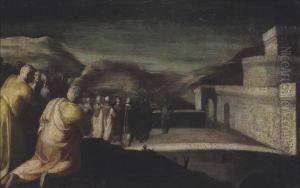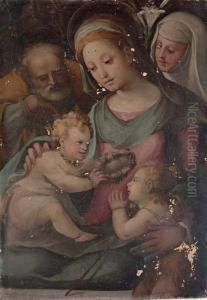Arcangelo Salimbeni Paintings
Arcangelo Salimbeni, also known as Arcangelo Baccio or simply Il Salimbeni, was an Italian painter of the late Renaissance period, active primarily in his native region of Siena. Born in 1536, Salimbeni was part of a family of artists; his father was a lesser-known painter, and his brother Ventura Salimbeni was also a well-regarded artist of the time.
Salimbeni's artistic career was largely influenced by the Mannerist style, which was prominent during the late Renaissance. This style was characterized by elongated figures, unusual complex poses, and often vivid colors. He was known for his religious works, altarpieces, and frescoes, which were commissioned by various churches and patrons in Siena and its environs.
In Siena, Salimbeni was influenced by the works of Domenico Beccafumi, one of the leading Mannerist painters in the region. Salimbeni's style evolved throughout his career, showing a blend of local Sienese traditions and the more progressive Mannerist tendencies coming out of Florence and Rome. His work is distinguished by clear, vivid colors, attention to detail, and often a dramatic use of lighting.
Salimbeni traveled to Venice and Rome, where he was exposed to the works of Titian and other Venetian masters, as well as the frescoes of Michelangelo in the Sistine Chapel. These experiences helped to shape his own painting technique and composition style. Despite these influences, Salimbeni's body of work remained deeply rooted in the Sienese artistic tradition.
The artist's religious commissions were particularly notable for their devotional intensity and intricate iconography. One of his most famous works is the frescoes in the Chapel of St. Catherine in Siena's church of San Domenico, which demonstrate his skill in creating complex narrative scenes.
Arcangelo Salimbeni died in 1589, leaving behind a legacy that is often overshadowed by his more famous contemporaries, but which nonetheless contributed to the richness of the Mannerist movement in Siena. His works can still be seen in various churches and museums, offering insight into the transitional period of late Renaissance art, where the refined elegance of the High Renaissance gave way to the more expressive and dynamic Mannerist style.

